gas LOTUS ELISE 2005 Owners Manual
[x] Cancel search | Manufacturer: LOTUS, Model Year: 2005, Model line: ELISE, Model: LOTUS ELISE 2005Pages: 205, PDF Size: 4.51 MB
Page 14 of 205
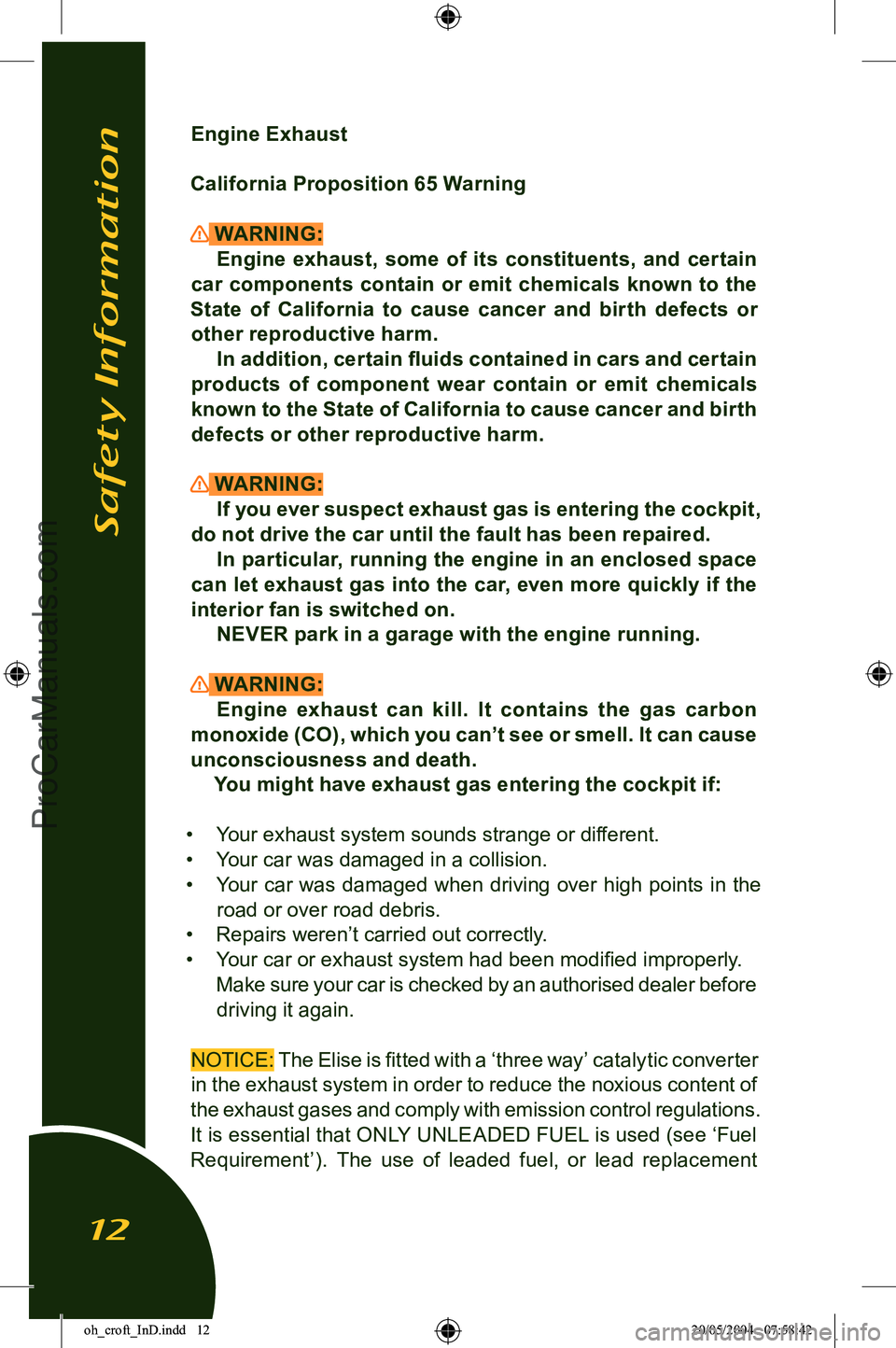
Engine Exhaust
California Proposition 65 Warning
WARNING: Engine exhaust, some of its constituents, and certain
car components contain or emit chemicals known to the
State of California to cause cancer and birth defects or other reproductive harm. In addition, certain fluids contained in cars and certain
products of component wear contain or emit chemicals
known to the State of California to cause cancer and birth
defects or other reproductive harm.
WARNING: If you ever suspect exhaust gas is entering the cockpit,
do not drive the car until the fault has been repaired.
In particular, running the engine in an enclosed space
can let exhaust gas into the car, even more quickly if the interior fan is switched on. NEVER park in a garage with the engine running.
WARNING:Engine exhaust can kill. It contains the gas carbon
monoxide (CO), which you can’t see or smell. It can cause
unconsciousness and death. You might have exhaust gas entering the cockpit if:
• Your exhaust system sounds strange or different.
• Your car was damaged in a collision.
• Your car was damaged when driving over high points in the
road or over road debris.
• Repairs weren’t carried out correctly.
• Your car or exhaust system had been modified improperly.
Make sure your car is checked by an authorised dealer before
driving it again.
NOTICE: The Elise is fitted with a ‘three way’ catalytic converter
in the exhaust system in order to reduce the noxious content of
the exhaust gases and comply with emission control regulations.
It is essential that ONLY UNLEADED FUEL is used (see ‘Fuel Requirement’). The use of leaded fuel, or lead replacement
Safety Information
12
oh_croft_InD.indd 1220/05/2004 07:58:42ProCarManuals.com
Page 15 of 205

petrol (LRP), will cause irreversible contamination of the pre-
cious metal catalysts and of the exhaust gas sensor used by the
computer controlled engine management system.
It is important that the Maintenance Schedule (see separate
booklet) is followed at the specified time and distance intervals
(this is a requirement of the warranty), and that the car is kept in proper operating condition. Failure to do so may result not only
in a loss of fuel economy and emission control, but may cause damage to the catalytic converter.
WARNING:
• If the engine malfunctions in any way (e.g by a change in sound) have the fault diagnosed and repaired promptly.
Continuing to drive the car with an engine misfire could cause the catalytic converter to overheat, with possible heat damage to other car components, and an engine bay
fire. Operation of the ‘Malfunction Indicator Lamp’ (MIL)
is fully described later in this handbook on page 49.
• DO NOT park or drive the car in areas where combustible material, such as dry grass or leaves, could come into
contact with the hot exhaust system. Under certain wind and weather conditions a grass fire could be initiated.
• DO NOT tamper with any electrical components with the battery connected. You could receive an electric shock
from the spark plug coils or initiate a car fire.
• DO NOT check or adjust any engine bay equipment with the engine running. Failure to comply with this may result
in you or your clothing becoming trapped.
• DO NOT use the car if a fuel leak is suspected, as may be indicated by a persistent smell of fuel. Have the fault
diagnosed and rectified without delay. A fuel leak may result in a fire or explosion.
• DO NOT touch or approach, any part of a hot exhaust
system. Failure to comply with this may result in you
receiving severe burns.
• DO NOT allow servicing or repairs to be carried out by unskilled persons as this may adversely affect the han
-
dling and safety features on your car. Lotus dealers have
trained staff who are best qualified to maintain your car
to the correct specification.
Safety Information
13
oh_croft_InD.indd 1320/05/2004 07:58:42ProCarManuals.com
Page 74 of 205
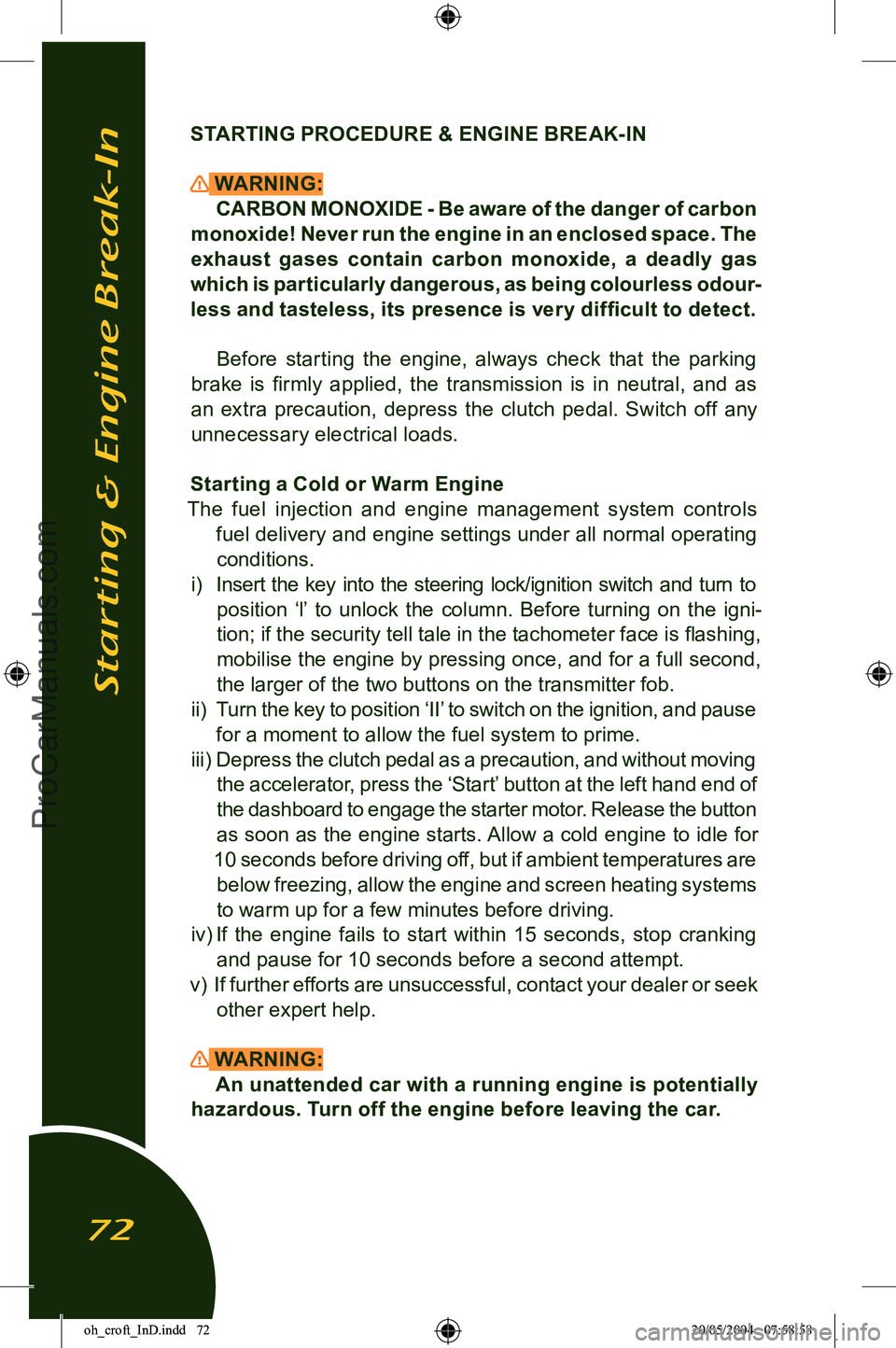
STARTING PROCEDURE & ENGINE BREAK-IN
WARNING:CARBON MONOXIDE - Be aware of the danger of carbon
monoxide! Never run the engine in an enclosed space. The
exhaust gases contain carbon monoxide, a deadly gas
which is particularly dangerous, as being colourless odour
-
less and tasteless, its presence is very difficult to detect.
Before starting the engine, always check that the parking
brake is firmly applied, the transmission is in neutral, and as
an extra precaution, depress the clutch pedal. Switch off any
unnecessary electrical loads.
Starting a Cold or Warm Engine
The fuel injection and engine management system controls fuel delivery and engine settings under all normal operating conditions.
i) Insert the key into the steering lock/ignition switch and turn to
position ‘l’ to unlock the column. Before turning on the igni
-
tion; if the security tell tale in the tachometer face is flashing, mobilise the engine by pressing once, and for a full second,
the larger of the two buttons on the transmitter fob.
ii) Turn the key to position ‘II’ to switch on the ignition, and pause
for a moment to allow the fuel system to prime.
iii) Depress the clutch pedal as a precaution, and without moving
the accelerator, press the ‘Start’ button at the left hand end of
the dashboard to engage the starter motor. Release the button
as soon as the engine starts. Allow a cold engine to idle for
10 seconds before driving off, but if ambient temperatures are below freezing, allow the engine and screen heating systems
to warm up for a few minutes before driving.
iv) If the engine fails to start within 15 seconds, stop cranking
and pause for 10 seconds before a second attempt.
v) If further efforts are unsuccessful, contact your dealer or seek
other expert help.
WARNING:
An unattended car with a running engine is potentially
hazardous. Turn off the engine before leaving the car.
Starting & Engine Break-In
72
oh_croft_InD.indd 7220/05/2004 07:58:58ProCarManuals.com
Page 77 of 205
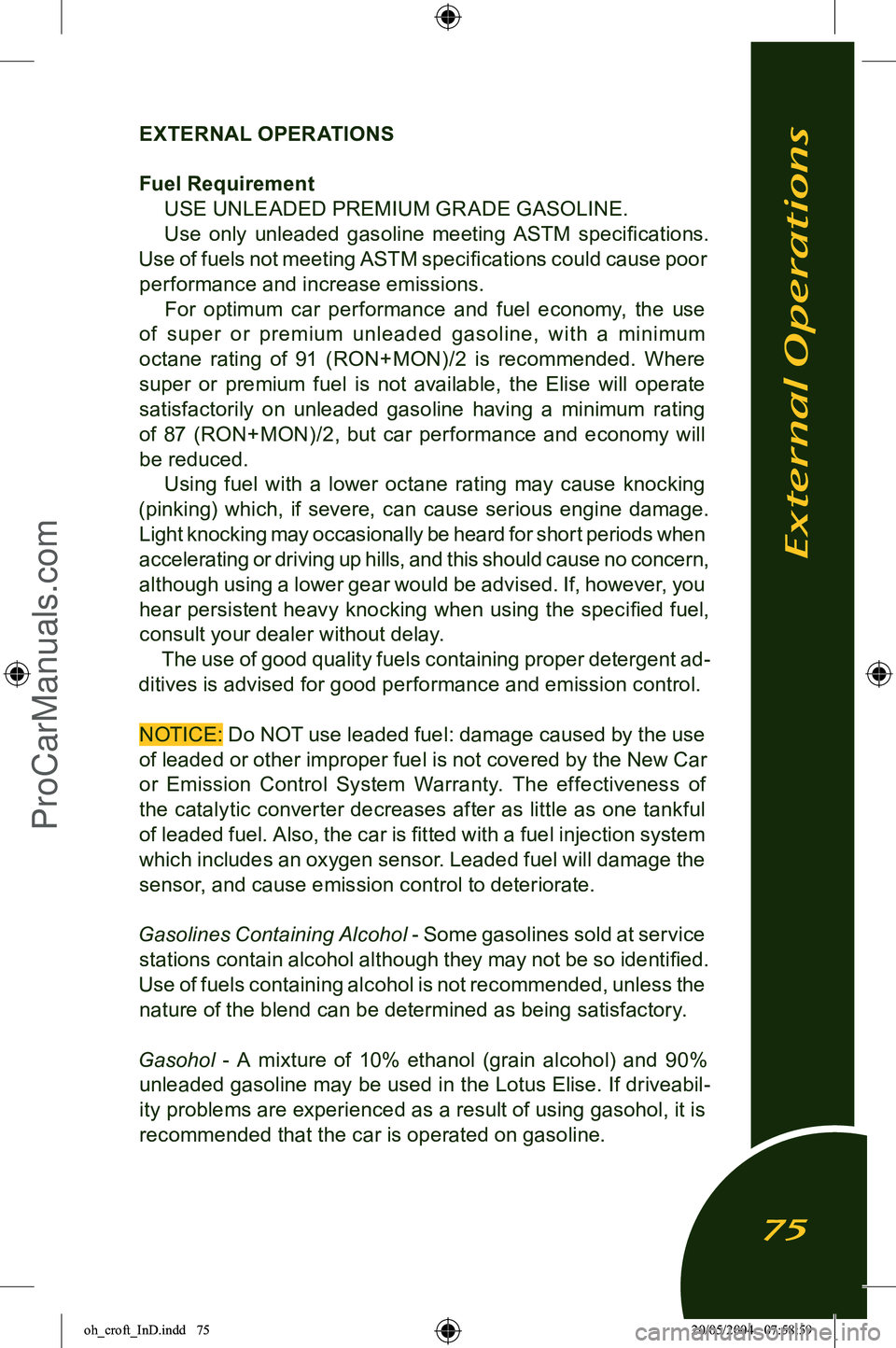
EXTERNAL OPERATIONS
Fuel Requirement USE UNLEADED PREMIUM GR ADE GASOLINE.
Use only unleaded gasoline meeting ASTM specifications.
Use of fuels not meeting ASTM specifications could cause poor performance and increase emissions.
For optimum car performance and fuel economy, the use
of super or premium unleaded gasoline, with a minimum
octane rating of 91 (RON+MON)/2 is recommended. Where
super or premium fuel is not available, the Elise will operate
satisfactorily on unleaded gasoline having a minimum rating
of 87 (RON+MON)/2, but car performance and economy will be reduced. Using fuel with a lower octane rating may cause knocking
(pinking) which, if severe, can cause serious engine damage.
Light knocking may occasionally be heard for short periods when accelerating or driving up hills, and this should cause no concern,
although using a lower gear would be advised. If, however, you hear persistent heavy knocking when using the specified fuel,
consult your dealer without delay.
The use of good quality fuels containing proper detergent ad
-
ditives is advised for good performance and emission control.
NOTICE: Do NOT use leaded fuel: damage caused by the use of leaded or other improper fuel is not covered by the New Car
or Emission Control System Warranty. The effectiveness of
the catalytic converter decreases after as little as one tankful
of leaded fuel. Also, the car is fitted with a fuel injection system
which includes an oxygen sensor. Leaded fuel will damage the sensor, and cause emission control to deteriorate.
Gasolines Containing Alcohol - Some gasolines sold at service stations contain alcohol although they may not be so identified.
Use of fuels containing alcohol is not recommended, unless the nature of the blend can be determined as being satisfactory.
Gasohol - A mixture of 10% ethanol (grain alcohol) and 90% unleaded gasoline may be used in the Lotus Elise. If driveabil
-
ity problems are experienced as a result of using gasohol, it is recommended that the car is operated on gasoline.
External Operations
75
oh_croft_InD.indd 7520/05/2004 07:58:59ProCarManuals.com
Page 78 of 205
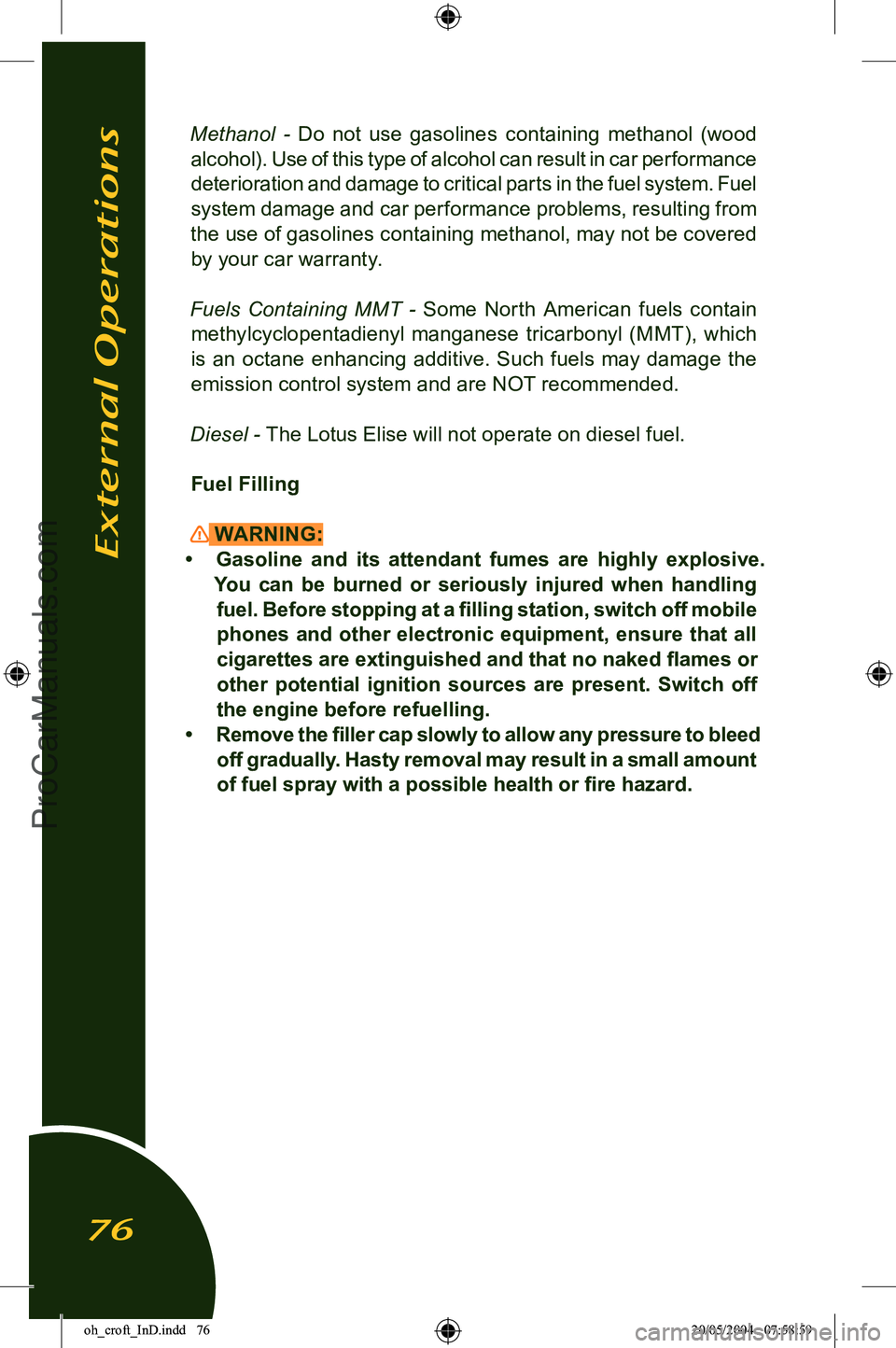
Methanol - Do not use gasolines containing methanol (wood
alcohol). Use of this type of alcohol can result in car performance deterioration and damage to critical parts in the fuel system. Fuel
system damage and car performance problems, resulting from
the use of gasolines containing methanol, may not be covered by your car warranty.
Fuels Containing MMT - Some North American fuels contain methylcyclopentadienyl manganese tricarbonyl (MMT), which
is an octane enhancing additive. Such fuels may damage the
emission control system and are NOT recommended.
Diesel
- The Lotus Elise will not operate on diesel fuel.
Fuel Filling
WARNING:
• Gasoline and its attendant fumes are highly explosive. You can be burned or seriously injured when handling
fuel. Before stopping at a filling station, switch off mobile phones and other electronic equipment, ensure that all
cigarettes are extinguished and that no naked flames or
other potential ignition sources are present. Switch off
the engine before refuelling.
• Remove the filler cap slowly to allow any pressure to bleed off gradually. Hasty removal may result in a small amount
of fuel spray with a possible health or fire hazard. External Operations
76
oh_croft_InD.indd 7620/05/2004 07:58:59ProCarManuals.com
Page 131 of 205
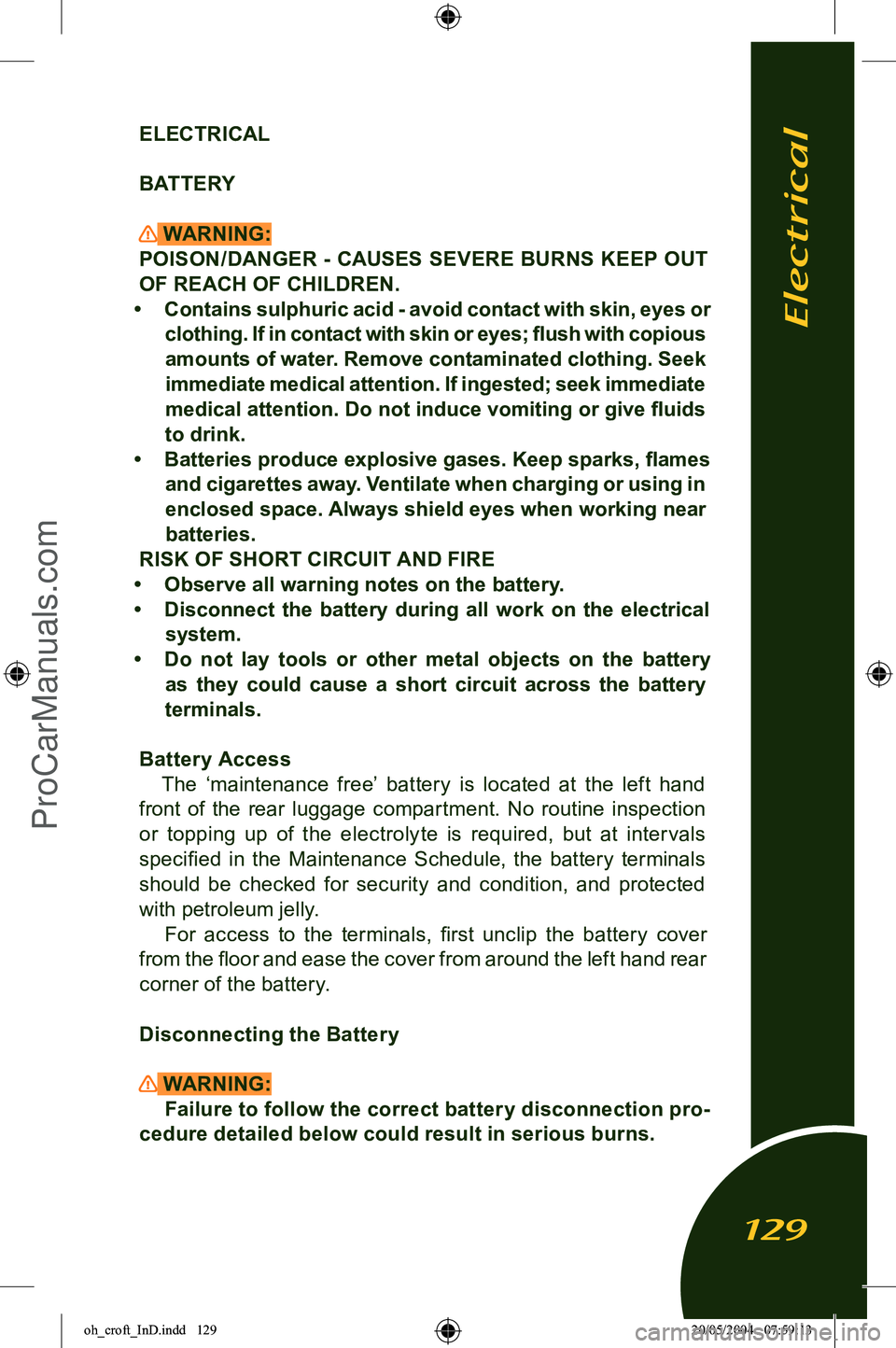
ELECTRICAL
BATTERY
WARNING:
POISON/DANGER - CAUSES SEVERE BURNS KEEP OUT
OF REACH OF CHILDREN.
• Contains sulphuric acid - avoid contact with skin, eyes or clothing. If in contact with skin or eyes; flush with copious amounts of water. Remove contaminated clothing. Seek
immediate medical attention. If ingested; seek immediate
medical attention. Do not induce vomiting or give fluids
to drink.
• Batteries produce explosive gases. Keep sparks, flames and cigarettes away. Ventilate when charging or using in
enclosed space. Always shield eyes when working near
batteries.
RISK OF SHORT CIRCUIT AND FIRE
• Observe all warning notes on the battery.
• Disconnect the battery during all work on the electrical system.
• Do not lay tools or other metal objects on the battery as they could cause a short circuit across the battery
terminals.
Battery Access The ‘maintenance free’ battery is located at the left hand
front of the rear luggage compartment. No routine inspection or topping up of the electrolyte is required, but at inter vals
specified in the Maintenance Schedule, the battery terminals
should be checked for security and condition, and protected
with petroleum jelly. For access to the terminals, first unclip the battery cover
from the floor and ease the cover from around the left hand rear corner of the battery.
Disconnecting the Battery
WARNING: Failure to follow the correct battery disconnection pro
-
cedure detailed below could result in serious burns.
Electrical
129
oh_croft_InD.indd 12920/05/2004 07:59:13ProCarManuals.com
Page 134 of 205
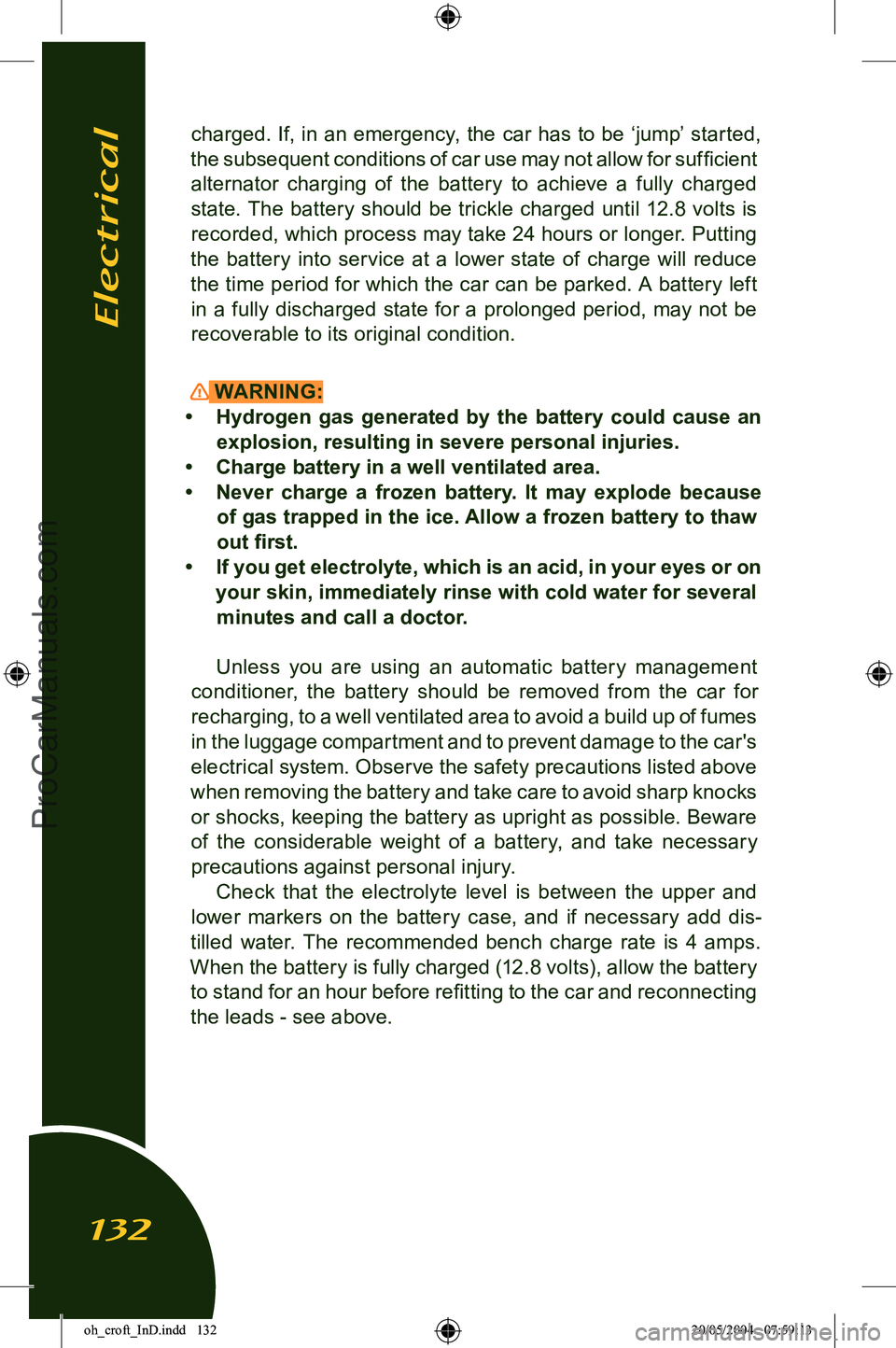
charged. If, in an emergency, the car has to be ‘jump’ started,
the subsequent conditions of car use may not allow for sufficient alternator charging of the battery to achieve a fully charged
state. The battery should be trickle charged until 12.8 volts is recorded, which process may take 24 hours or longer. Putting
the battery into service at a lower state of charge will reduce
the time period for which the car can be parked. A battery left
in a fully discharged state for a prolonged period, may not be recoverable to its original condition.
WARNING:
• Hydrogen gas generated by the battery could cause an explosion, resulting in severe personal injuries.
• Charge battery in a well ventilated area.
• Never charge a frozen battery. It may explode because of gas trapped in the ice. Allow a frozen battery to thaw
out first.
• If you get electrolyte, which is an acid, in your eyes or on your skin, immediately rinse with cold water for several minutes and call a doctor.
Unless you are using an automatic batter y management
conditioner, the battery should be removed from the car for
recharging, to a well ventilated area to avoid a build up of fumes
in the luggage compartment and to prevent damage to the car's
electrical system. Observe the safety precautions listed above
when removing the battery and take care to avoid sharp knocks
or shocks, keeping the battery as upright as possible. Beware
of the considerable weight of a battery, and take necessary precautions against personal injury. Check that the electrolyte level is between the upper and
lower markers on the battery case, and if necessary add dis
-
tilled water. The recommended bench charge rate is 4 amps.
When the battery is fully charged (12.8 volts), allow the battery
to stand for an hour before refitting to the car and reconnecting
the leads - see above.
Electrical
132
oh_croft_InD.indd 13220/05/2004 07:59:13ProCarManuals.com
Page 136 of 205

v) A spark will occur at the first disconnection of a jumper cable, so it is essential that the first disconnection is made from the
slave car earth. Both batteries (especially the
discharged one) will be ‘gassing’ heavily at this time, and if the first disconnection is made at a battery terminal, there is
a danger that the hydrogen gas may be ignited by the spark
with a resultant explosion.
vi) Have the cause of the flat battery investigated and rectified,
and trickle charge the battery as detailed above.
WARNING:
• Risk of damage and serious personal injury due to
shortcircuit.
• Use only jumper cables of adequate cross-section, fitted
with completely insulated alligator clamps. The cables must be long enough to allow that neither cars nor cables
touch each other.
• Follow all warnings and instructions of the jumper cable
manufacturer.
• When connnecting the jumper cables, keep them away
from engine moving parts.
• The two cars must not contact each other, or current could flow as soon as the positive terminals are connected.
• When the first clamp on each cable is connected, the other clamp on that cable must be held carefully to make sure it does not come into contact with either another cable
clamp or either car.
• Ensure that tools or metal watches or jewellery do not contact the battery terminals or live car parts.
NOTICE:
• Improper jumper cable connection can damage the alternator
and other electrical components.
• Do not attempt to push or tow start the car, as damage to the
catalytic converter or other parts could be caused.
Electrical Accessories Owners should note that the only approved extras and modi
-
fications are those which are specified by Lotus and carried out by Lotus or by an authorised dealer. Neither Lotus Cars Ltd. or
Lotus Cars Inc. accept any liability whatsoever for defects which arise from extras or modifications which are not approved by
Lotus Cars Ltd.
Electrical
134
oh_croft_InD.indd 13420/05/2004 07:59:14ProCarManuals.com
Page 144 of 205
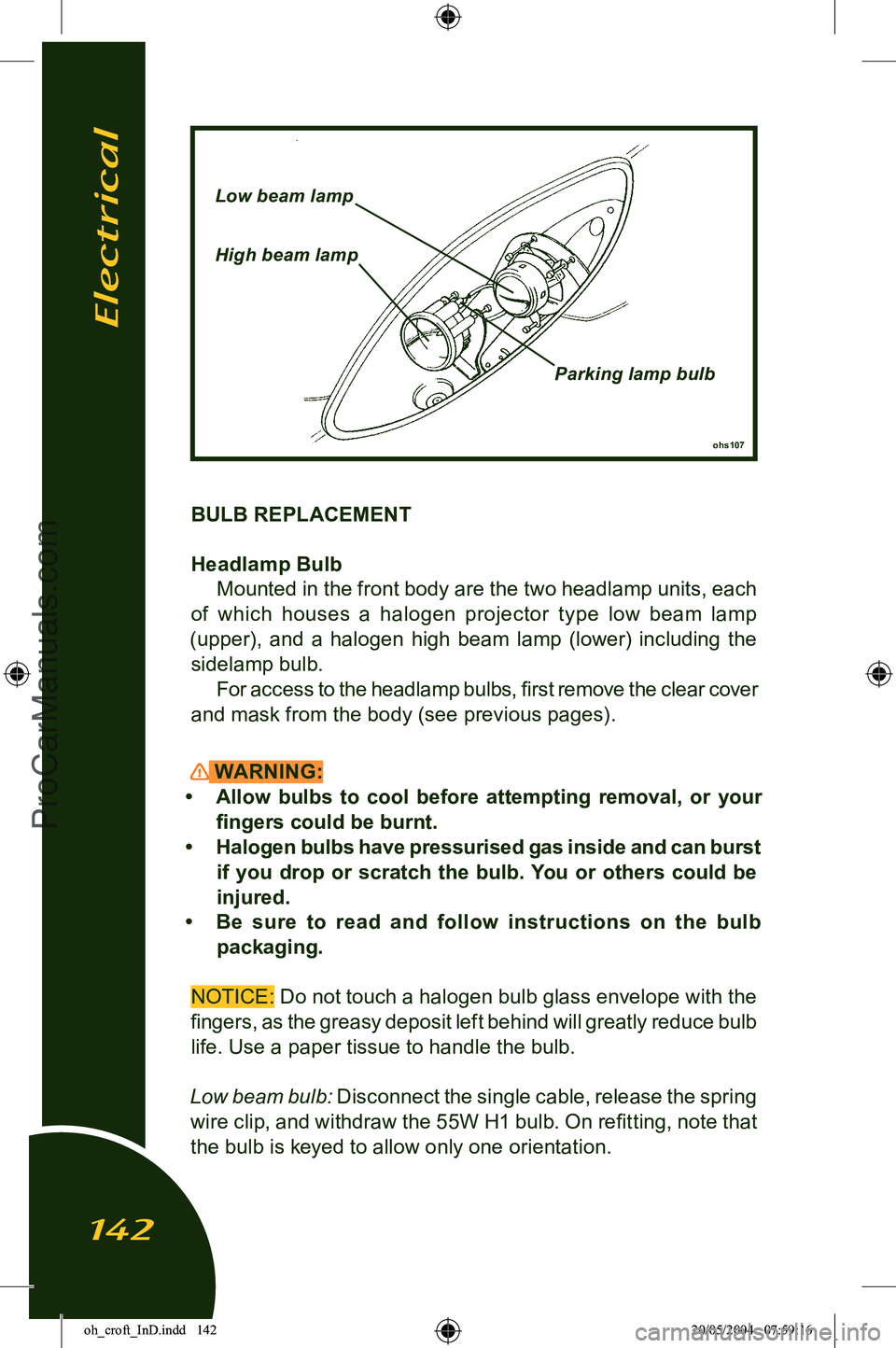
BULB REPLACEMENT
Headlamp BulbMounted in the front body are the two headlamp units, each
of which houses a halogen projector type low beam lamp
(upper), and a halogen high beam lamp (lower) including the sidelamp bulb. For access to the headlamp bulbs, first remove the clear cover
and mask from the body (see previous pages).
WARNING:
• Allow bulbs to cool before attempting removal, or your fingers could be burnt.
• Halogen bulbs have pressurised gas inside and can burst if you drop or scratch the bulb. You or others could be
injured.
• Be sure to read and follow instructions on the bulb
packaging.
NOTICE: Do not touch a halogen bulb glass envelope with the
fingers, as the greasy deposit left behind will greatly reduce bulb life. Use a paper tissue to handle the bulb.
Low beam bulb: Disconnect the single cable, release the spring wire clip, and withdraw the 55W H1 bulb. On refitting, note that the bulb is keyed to allow only one orientation.
ohs107
Low beam lamp
High beam lamp
Parking lamp bulb
Electrical
142
oh_croft_InD.indd 14220/05/2004 07:59:16ProCarManuals.com
Page 181 of 205

- fuel vapour pressure sensor
Exhaust System
- exhaust manifold
- catalytic converter, heat shields, gaskets and fasteners*
Engine Emission Control System Sensors
- electronic control module (ECM)*
- engine coolant temperature sensor (ECTS)
- air flow meter
- crankshaft sensor
- idle air control valve (IACV)
- wheel speed sensors
- throttle position sensor (TPS)
- knock sensor
- oxygen sensors
- oil control valves for VVTL-i
- oil pressure switch for VVTL-i
- camshaft position sensor
- coolant thermostat
On Board Diagnostics (OBD)
- malfunction indicator lamp (MIL)
- data link connector and harness
Miscellaneous Parts used in the Above Systems
- hoses
- switches, sensors and solenoids
- gaskets and seals
- wires, harnesses and connectors
* major emission control components - see page 171
Federal Emission Warranty
179
oh_croft_InD.indd 17920/05/2004 07:59:24ProCarManuals.com